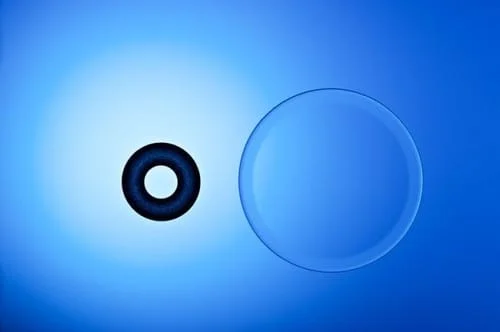
Watch a Video from Good Morning America about the Kamra Inlay
Read an article from the Wall Street Journal about the Kamra Inlay and Reading
Read an article from ABC News Talking about the Kamra Inlay
The KAMRA™ Inlay surgery procedure, or pinhole technology, is ideal for those people who desire to enjoy their vision without the continual aggravation of having to use reading glasses or contact lenses.
KAMRA Inlay surgery procedure can provide you with a natural range of both near and far vision without blurriness. Additionally, it may also provide long-term performance that delivers nearly clear vision even as presbyopia progresses. Presbvopia is a condition where as you age (in your 40’s), the muscles around the lens in your eye weaken which decreases the focusing power of your eye and typically requires the use of reading glasses.
The KAMRA Inlay having been reviewed for safety and effectiveness in the United States by the FDA and is now available.
Overview of Kamra™ Inlay or Pinhole Refractive Surgery
Your cornea is the transparent, dome-shaped surface on the front of your eye, which covers your iris (colored part of your eye) and pupil. The cornea significantly accounts for the focusing power of your eye and works together with the lens (inside your eye) to focus objects so you can see.
Kamra™ Inlay Surgery is a procedure used to treat Presbyopia, which is an age-related vision condition that makes it difficult to focus on close objects. Please note that medical practices and information may have evolved since then, so it's essential to consult with a healthcare professional for the latest and most accurate information.
Here is a general overview of Kamra™ inlay surgery:
- Purpose:
- Kamra™ inlay surgery is designed to reduce or eliminate the need for reading glasses in individuals with presbyopia.
- Presbyopia typically occurs around the age of 40 and results in a loss of near vision.
- Procedure:
- During the surgery, a small, thin, doughnut-shaped device called the Kamra™ inlay is implanted in the cornea of one eye.
- The inlay is placed in the non-dominant eye, and the brain learns to rely more on the dominant eye for distance vision and the non-dominant eye for close-up vision.
- Mechanism:
- The Kamra™ inlay works by using the pinhole effect to increase the depth of focus. It allows only focused light to enter the eye, improving near vision without significantly affecting distance vision.
- Candidates:
- The procedure is generally recommended for individuals who are experiencing presbyopia and are seeking a solution to reduce their dependence on reading glasses.
- Candidates for Kamra™ inlay surgery should have good distance vision in both eyes and be in good overall eye health.
- Recovery:
- Recovery time after Kamra™ inlay surgery is typically short, and most patients can resume normal activities within a few days.
- Some patients may experience temporary side effects such as glare or halos, but these often improve with time.
- Consultation:
- Before deciding on Kamra™ inlay surgery, individuals should undergo a thorough eye examination and consultation with an eye care professional to determine if they are suitable candidates.
It's crucial to consult with an eye care specialist for the most up-to-date information on Kamra™ inlay surgery, as advancements in medical technology and practices may have occurred since my last update. Always rely on the advice of qualified healthcare professionals for personalized information regarding your specific situation.
What Is the Kamra™ Inlay?
The KAMRA Inlay is a microscopic and small device that is implanted on your cornea toward the center of your eye. The bio-compatible inlay is about 3.8 mm in diameter with a 1.6 mm central opening which enables light to move directly from the front of the eye to the back of the eye, extending the natural range of vision. The brown portion of the inlay has over 8,000 laser-created micro-perforations in it allowing oxygen and nutrients to enter the cornea. This explains why rejection of the implant is rare.
KAMRA inlay surgery is a procedure where the laser produces a small pocket (not a flap) in the cornea in 15 seconds. The paper thin Kamra inlay is then inserted into this pocket and centered over the pupil. Special photographs of the cornea are taken before the surgery to be sure the inlay is properly centered over the visual axis of the pupil
The KAMRA inlayis also referred to as “pinhole” technology because it is based on “Pinhole” optics. The first camera invented was a pinhole camera. Looking through a small pinhole eliminates aberrations in the visual system and improves both near and distance vision. When we squint to see better we are creating a pinhole effect. You can simulate this by making a small pinhead-sized opening in a piece of paper and then looking at print through the pinhole with the other eye closed.
The entire procedure is performed under a surgical microscope and usually takes about 15 minutes. KAMRA Inlay surgery is typically performed on an outpatient basis so you come to the laser surgery center and you go home about 30 minutes later.
Do I Need a Kamra™ Inlay Procedure?
Karma Inlay surgery is an elective procedure for qualified candidates who are tired of the hassle of wearing reading glasses or contact lenses to read.
Non-Surgical Options to the KAMRA Inlay Procedure
Reading glasses, progressive bifocals, contact lenses, and “mono-vision” are the non-surgical alternatives to the KAMRA inlay procedure.
Am I Candidate for KAMRA Inlay Surgery?
A good candidate for the KAMRA Inlay procedure are people with a normal eye exam and excellent uncorrected distance vision in their dominant eye. Ideally their non-dominant eye also has good vision and its even better if the eye is slightly nearsighted. The procedure can be done after LASIK or even cataract surgery. Or LASIK or PRK surgery can be performed first in preparation for a later Kamra inlay
Before considering the KAMRA inlay procedure you should find a highly qualified eye surgeon who performs the procedure, Have a complete eye examination, and talk with your eye surgeon about the alternatives to treatment, potential benefits, complications, risks, and time required for healing.
Complications and Risks of Kamra™ Inlay Surgery
The KAMRA Inlay procedures received FDA approval in 2015. The KAMRA Inlay procedure may not eliminate the need for reading glasses. Check with an experienced eye surgeon, like the one at Trusted LASIK Surgeons™ to discuss if you are a good candidate for this procedure. As with any surgical procedure, there are some possible risks that serious complications may develop from a corneal transplant, such as:
Moderate and severe complications associated with the KAMRA inlay procedure include the following:
- blurred vision
- difficulties with contrast sensitivity and color disturbances
- night vision problems
- double vision
- ghost images, glare, and halos.
Other possible complications from the KAMRA Inlay procedure include:
- pain, dryness, burning, discomfort and redness in the eye
- infection, swelling, thinning, or inflammation of the cornea
- changes in your near and far vision.
All of these complications can be treated. In most cases problems stemming from a KAMRA Inlay procedure can be mitigated if not eliminated or corrected.
Minor complications include dry eye, slight haze making the vision cloudy. These are treated with eye drops. often for several weeks. Foreign body feeling, redness, and swelling typically decrease during the first week, but if these complications persist, you should contact your eye surgeon who can prescribe medication.,
Significant loss of vision and rejection of the implant are very rare. In the event of significant complications, the Karmra inlay can be removed. During clinical studies where the inlay was removed, a patient’s vision generally returned to the level he or she had prior to the implantation with the KAMRA inlay. However, if you have the KAMRA inlay surgery and the inlay is later removed, there is no guarantee your vision will return to exactly what it was before surgery or that your eye will not have permanent damage.
Vision Correction Treatments After Kamra™ Inlay Surgery
Non-Surgical Treatments
The Kamra is designed for what we call “social vision”, meaning text messages, menus, computer monitors, GPS in the car, signing a credit card etc. Glasses may still be necessary for prolonged reading.
Surgical Treatments
Other refractive procedures are available after a Kamra Inlay procedure. If the vision is not adequate, a PRK surgery can be performed to enhance the near vision, typically 2 or 3 months after the inlay is placed. Is some circumstances, the PRK and the Kamra insertion can be performed at the same time. Should the patient later develop a cataract it can be removed with the inlay left in place so the patient will retain both distance and reading vision.
Insurance Coverage
If you are planning to have KAMRA Inlay surgery, you should contact your health insurance company and ask if there are any requirements you need to meet before having surgery to see if you can be covered. In addition, you should ask what costs are covered (if any), including post-operative care such as follow up visits with your eye surgeon.
How To Find a Qualified Kamra™ Inlay Surgeon
If you are interested in having a KAMRA Inlay procedure, Trusted LASIK SurgeonsTM strongly recommends you find an expert refractive surgeon. Certified Kamra surgeons are listed on the Acufocus website
Those refractive specialists featured at Trusted LASIK SurgeonsTM who perform KAMRA Inlay procedures typically have proven experience and most have been professionally recognized for their expertise and contributions in this refractive surgery.
If you are thinking you would like to have KAMRA Inlay surgery, please visit our LASIK Directory and contact a surgeon closest to you. Even if that surgeon does not perform the KAMRA Inlay procedure, he or she should be able to refer you to a proven expert who does perform this procedure.
You are also welcome to contact us directly and we will do our best to help you find an experienced corneal surgeon who can help you.
Here are a few images of what the Kamra Inlay looks like:

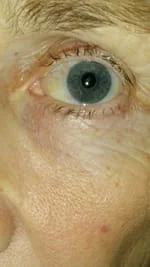
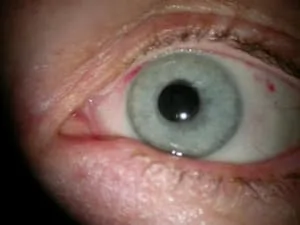
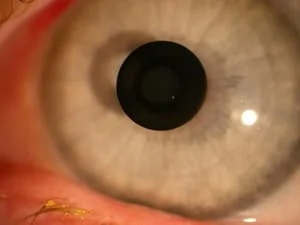
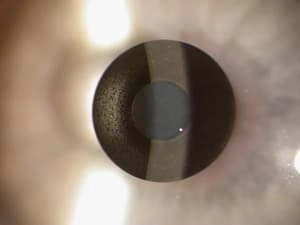
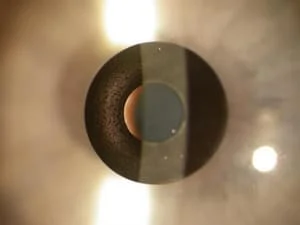
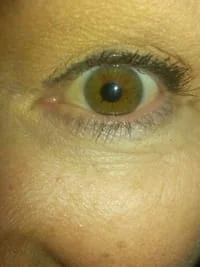
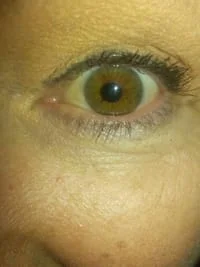
To find a vision correction expert surgeon who has qualified to be listed in the Trusted LASIK Surgeons™ Directory or the Trusted Cataract Surgeons™ Directory nearest to you, please visit:
Find a Trusted Cataract Surgeon™
We invite you to review our qualification process, each surgeon's profile, and select your LASIK, cataract or other refractive surgeon with confidence.
When you select an eye surgeon from the Trusted Cataract Surgeons™ Directory or Trusted Cataract Surgeons™ Directory, you will meet with a vision correction surgery expert who is a trusted eye surgeon. You will gain the advice, wisdom, and expertise of a highly qualified refractive surgeon at an exceptional value.
To learn more about screening process and standards used by Trusted LASIK Surgeons™ to qualify surgeons please visit:
How Are LASIK and Cataract Surgeons Qualified at Trusted LASIK Surgeons™?

